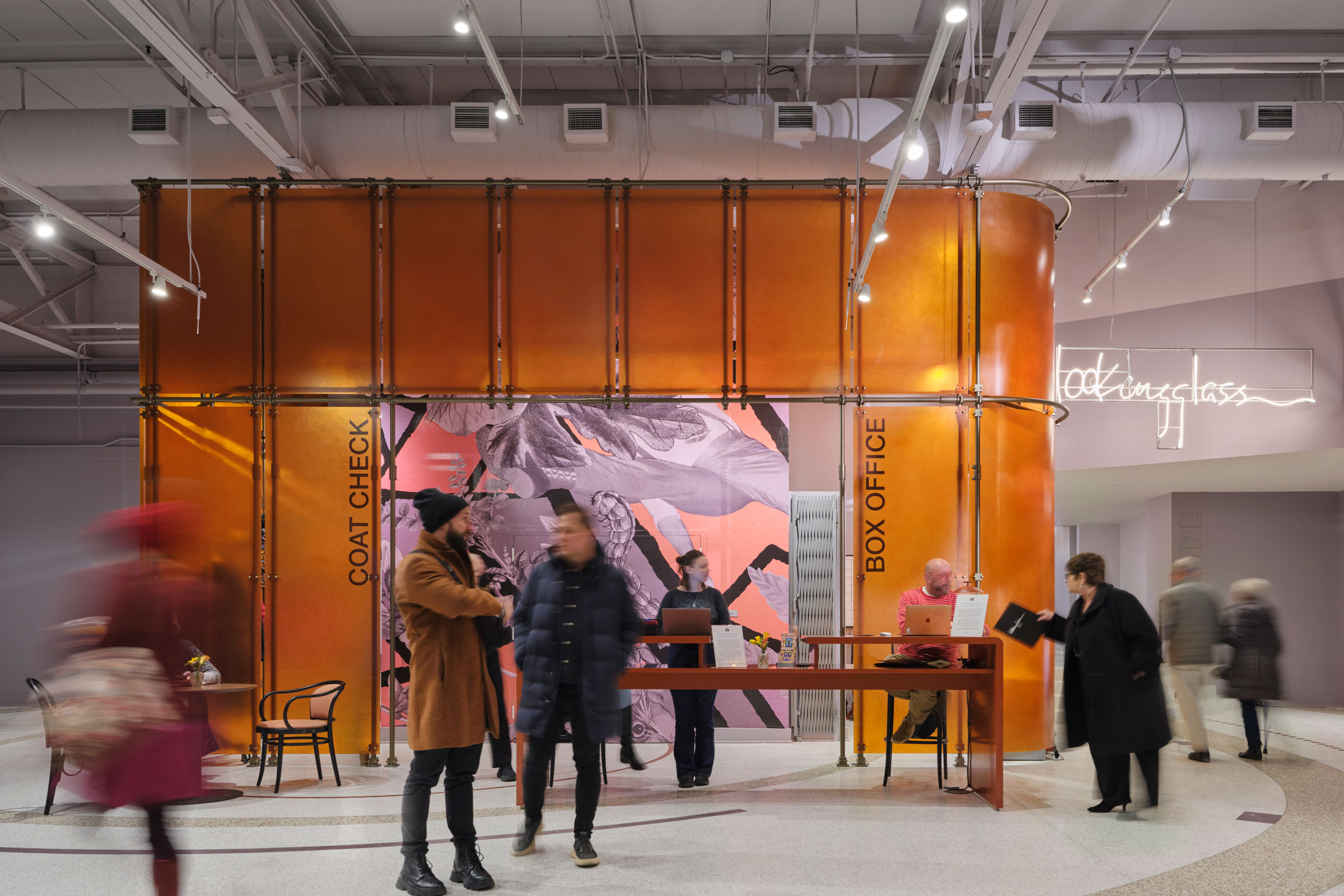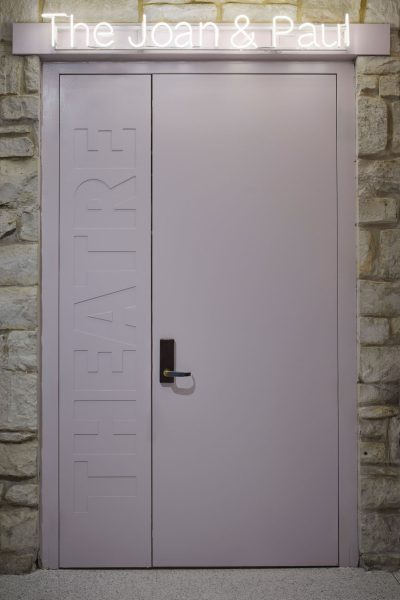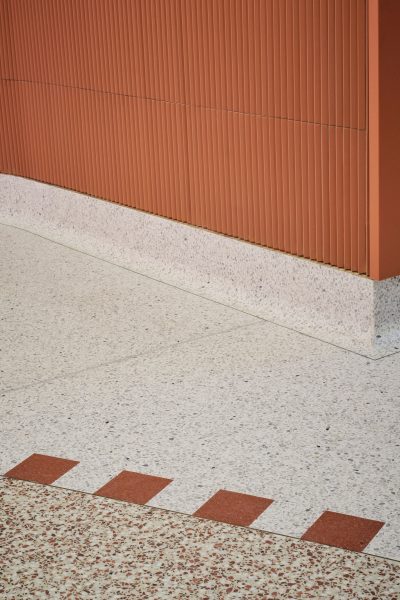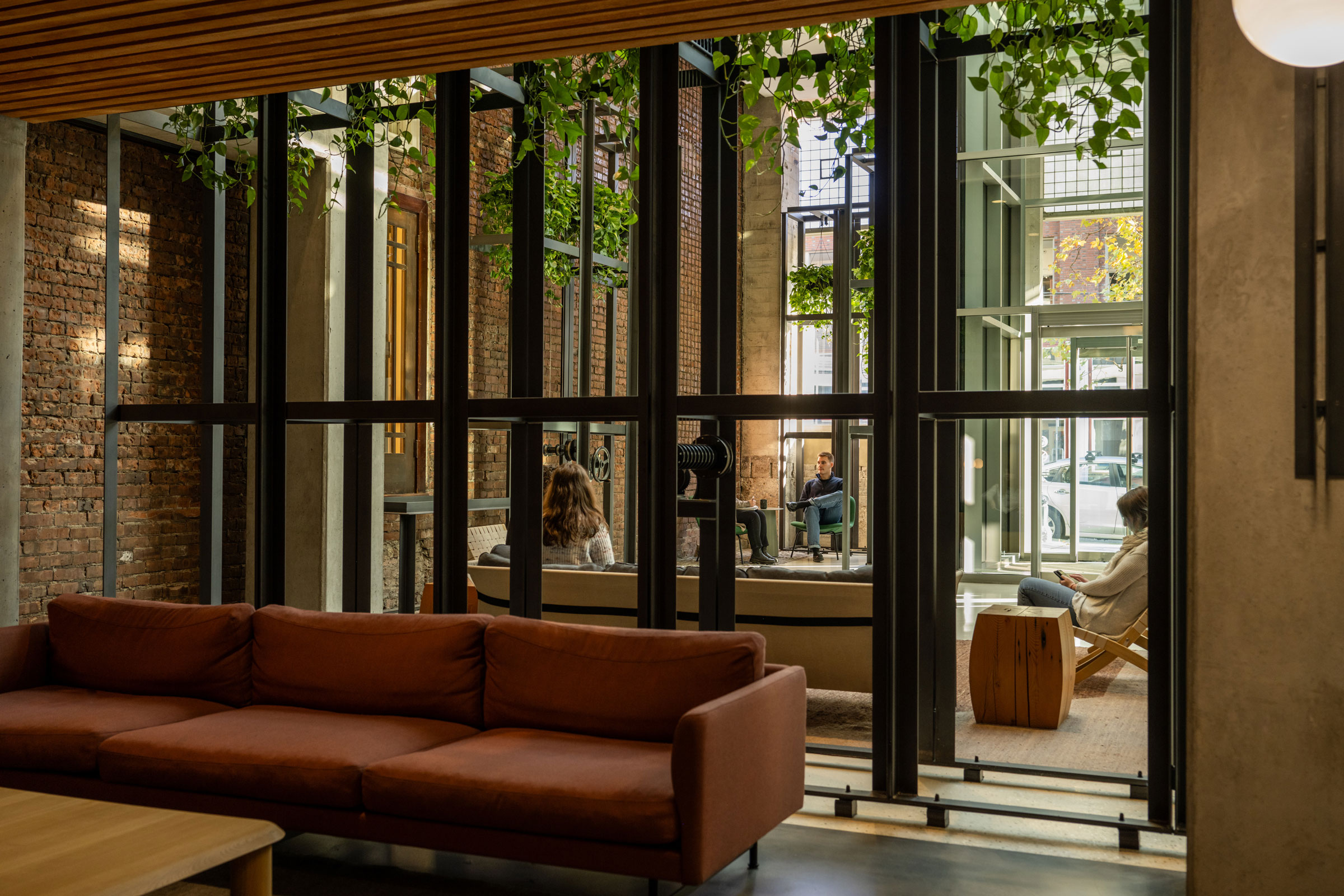Story at a glance:
- The Lookingglass Theatre expansion unites mainstage and city, with a street front entrance, vibrant lobby, front of house support spaces, daytime cafe and bar, and flexible rehearsal, education, and outreach space.
- Working Group 1 and Wheeler Kearns Architects collaborated to expand the creative hub within a historic landmark.
Since its inception in 1988 Lookingglass Theatre Company has distinguished itself as an ensemble-based incubator, integrating an improvisational process with training in dance, music, and circus arts.
After more than 20 years in a dynamic theatrical home cloistered within the historic Chicago Avenue Pumping Station, Lookingglass reopened its doors with an amplified presence on Chicago’s Magnificent Mile.
Supported by municipal space and state funding, the company initiated a significant expansion to enhance its public-facing footprint while reaffirming a drive to deliver exhilarating, inspirational theater accessible to all. The expansion represents a major milestone for the company within this historic building that survived the Great Chicago Fire. Mainstage and city are now connected with a vibrant street-facing program that reflects the company’s ethos.
Having designed the Lookingglass mainstage as part of Working Group 1 with Morris Architects Planners in the early 2000s, I was invited to take part in their next act, in partnership with Wheeler Kearns Architects—an exceptional architecture firm devoted to the creation of spaces embodying each client’s purpose, energy, and vision. Together we delivered more than a renovation; this project is a reinvention that brings the company’s spirit to the street while redefining how this cultural landmark engages its city.
The project includes a new street-facing lobby intended as a clear civic gesture and connection with the theater. It is a flexible, naturally lit space for public gatherings; it includes an open, engaging and accessible box office; universal public restrooms; rehearsal, education, and outreach areas designed to support year-round activities for artists, students, and community partners; a café and bar to support gathering throughout the day and to promote neighborhood engagement outside scheduled performances.
Constraints Become Catalysts
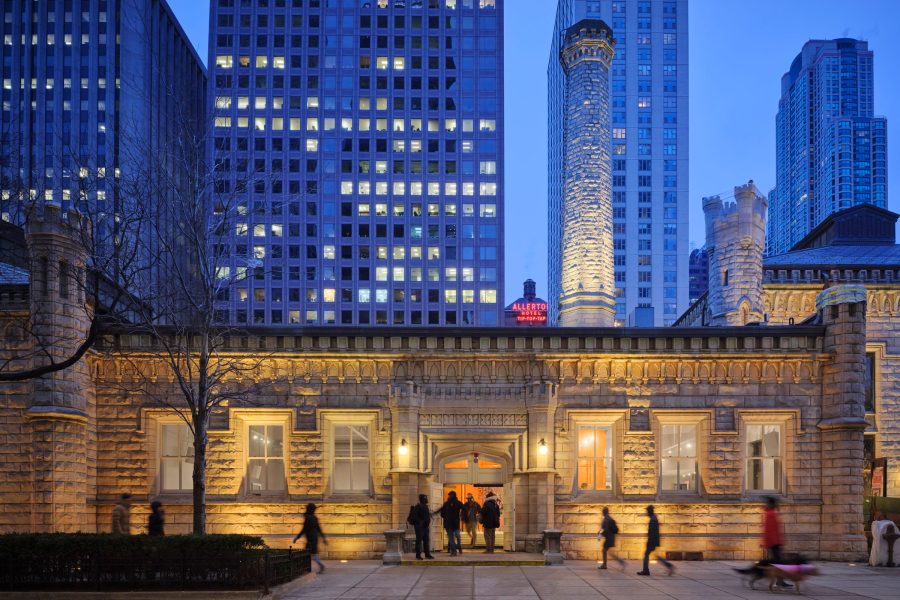
Photo by Tom Harris, courtesy of Wheeler Kearns Architects
The transformation of space within this functioning public utility and Chicago landmark into a vital platform for Lookingglass and the city demanded ingenuity, precision, and restraint. Strict preservation ordinances limiting physical alteration of the structure, a modest budget, and a fast-paced, grant-driven schedule set clear constraints.
Adaptive reuse was prioritized throughout the project, integrating existing core infrastructure, mechanical, and electrical systems. Perimeter envelope and structural elements were preserved, receiving low-impact finishes in lieu of full replacement. In the newly conceptualized all-gender restrooms, original facilities were reimagined to minimize expense.
Other sustainable gestures included the introduction of terrazzo flooring, envisioned as a central design gesture featuring pathways inspired by ancient celestial maps, intended to guide visitors through points of entry, past historic public utilities, new amenities, ultimately linking the lobby to the mainstage. The material’s durability aligned with the project’s sustainable objectives in minimizing future maintenance and replacement requirements.
One technical challenge, a 24-inch elevation differential between two main floor levels, was addressed with a strategically located ramp and stair, providing both a functional and visually impactful solution serving as a ceremonial threshold between the street-facing and interior lobbies.
Putting Art Stage Center
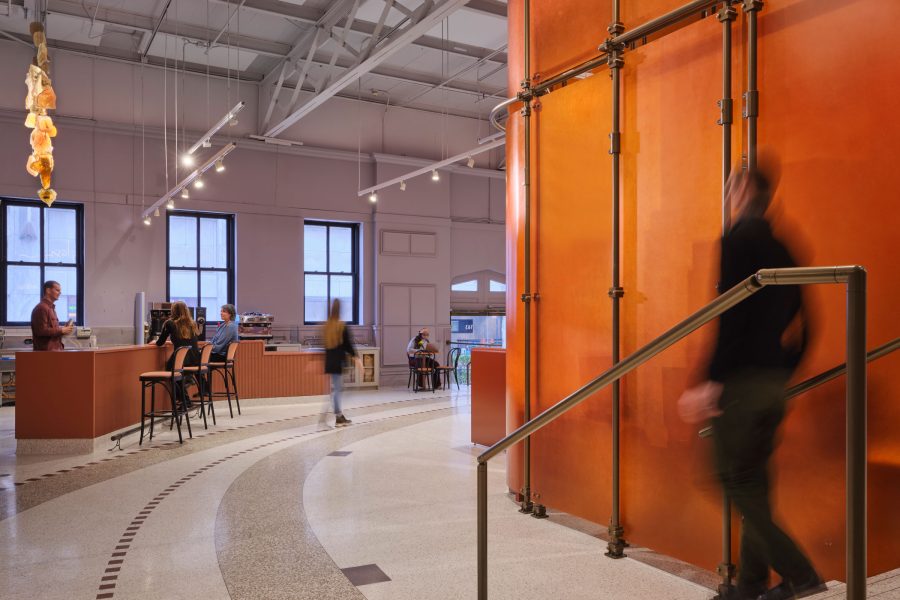
Photo by Tom Harris, courtesy of Wheeler Kearns Architects
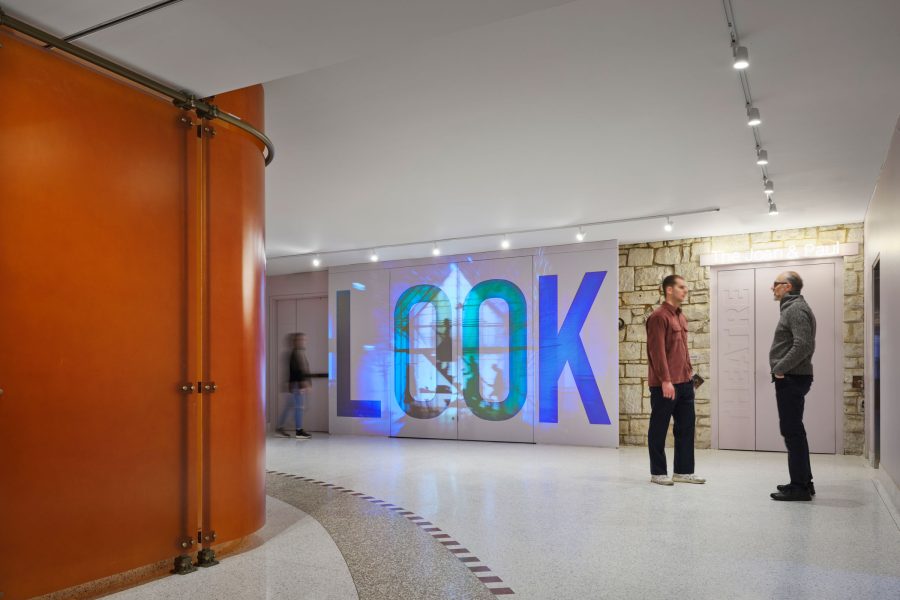
Photo by Tom Harris, courtesy of Wheeler Kearns Architects
At the heart of the lobby stands a glowing centerpiece supported by a modular framing system commonly found in industrial applications. Repurposed for this context, the system delivers efficient, cost-effective deployment and advances sustainability, referencing the adaptability inherent in the theater’s 2003 mainstage “machine for theater” design. Both scrim and lantern in nature, the hand-cast amber fiberglass encourages movement around essential programmatic spaces, including the box office, coat check, and universal restrooms, while establishing a cohesive architectural language that embodies the theatre’s innovative character.
Art and technology merge to play a key role in the new public-facing identity. A prominently placed projection surface fosters engagement, acting as a dynamic billboard to showcase work by Lookingglass and its community partners. Artfully placed neon glows with the name of the company and the donors for which the mainstage is now named. They foreground the warmth of the renovated space expressed in each new material and thoughtful design element—each conceived with longevity, versatility, and Lookingglass’ vibrant spirit in mind.
Future-Proofing a Civic Landmark
- Photo by Tom Harris, courtesy of Wheeler Kearns Architects
- Terrazzo flooring guides visitors through points of entry, past historic public utilities and new amenities, ultimately linking the lobby to the mainstage. Photo by Tom Harris, courtesy of Wheeler Kearns Architects
This renovation is poised to significantly amplify the theater’s contribution to the public realm. Presently it enhances the historic pumping station’s function as a site where community and performance seamlessly intersect. The revitalized theatrical hub is distinguished not only by increased functionality but also by its expanded generosity, embodying a cultural landmark re-envisioned to more effectively serve its city.
Our design for this public venue incorporates adaptable spaces intended to support year-round activities—including performance, educational initiatives, workshops, and collaborative partnerships—enabling Lookingglass and its creative partners to serve diverse audiences, enhance youth participation, and advance arts education across all age groups. The new facility fosters strategic collaborations with schools, neighborhood entities, and local artists, thereby extending the reach and effectiveness of Lookingglass’s programs.
Importantly, the design foregrounds physical and social equity. The addition of a prominent, street-facing entrance accentuates the theater’s status as a civic resource. Internally, features like a sculptural staircase and ramp, all-gender restrooms, and clear wayfinding empower visitors of all ages and abilities to navigate the space independently. These inclusive elements ensure patrons are welcomed with dignity, reflecting the theater’s commitment to a broad and multigenerational audience.
Through the Lookingglass
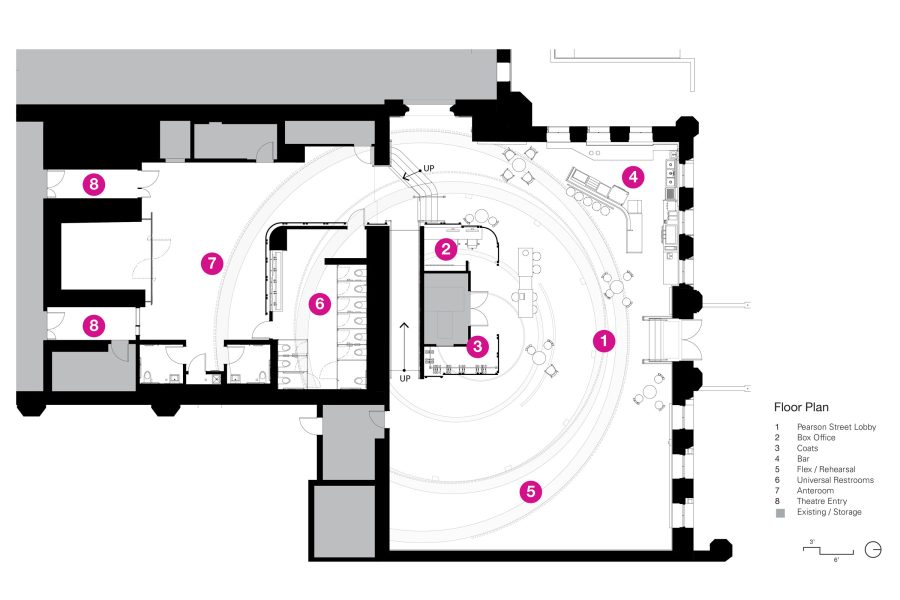
Floor plan of Lookingglass Theatre. Drawing courtesy of Wheeler Kearns Architects
This project demanded a resourceful design approach, and we are proud of what we’ve achieved with our client. Through strategic, theatrical interventions, we’ve reimagined a once-cloistered venue as an open, inclusive, and unmistakably Lookingglass space—aligning architecture with the theater’s ethos of invention, adaptability, and connection with the community. Through reuse of existing infrastructure, minimal permanent alterations, and a plan for longevity and flexibility, the renovation embodies the core principles of sustainability while celebrating the theater’s spirit. As a result the design delivers a transformative experience that honors the past while boldly redefining the theater’s future promise.
Project Details
Project: Lookingglass Theatre Lobby
Location: Chicago
Completion: February 2025
Architects: Working Group 1, Wheeler Kearns Architects
Structural Engineer: Silman / TYLin
General Contractor: Norcon
Projection Design: Liviu Pasare
Neon Artist: Clare Brew
Calli Verkamp of Wheeler Kearns Architects contributed to this article.

